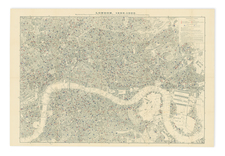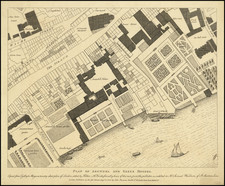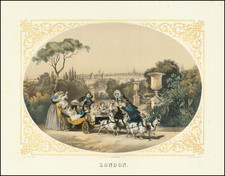Queen Victoria's First Grand Review of the Newly Established Volunteer Force
Fine example of this scarce map of the assemblage of Volunteer Troops on the occasion of the first grand review of Volunteer Troops on June 23, 1860.
The map illustrates the assembled forces, with a color key identifying Artillery, Mounted Volunteers, Infantry and Engineering Corps, with a second color key identifying the banners of 10 different groups of volunteers. A total of 19,188 volunteer troops were noted to have participated.
The event marked the culmination of Britain's revival of its volunteer forces following the end of the Crimean War. After and attempted assassination of Emperor Napoleon III on January 14, 1858, by Felice Orsini, it was determined that Orsini had been in Birmingham, England, where he had obtained bombs. The British Army at the time was stretched thin, and the risk of invasion by the much larger French Army required mustering larger military forces. On April 29, 1859, the Second Italian War of Independence began, with great concern that Britain might be caught up in a wider European conflict.
Volunteer Force
The Volunteer Force was a citizen army of part-time rifle, artillery and engineer corps, created in 1859 and organized locally throughout the British Empire. Originally organized as autonomous groups, the units of volunteers became increasingly integrated with the British Army after the Childers Reforms in 1881, before forming part of the Territorial Force in 1908.
On May 12, 1859, British Secretary of State for War Jonathan Peel issued a circular letter to lieutenants in counties throughout England, Wales and Scotland, authorizing the formation of volunteer rifle corps and of artillery corps in defended coastal towns. The directive provided that volunteer corps were to be formed pursuant to the Volunteer Act 1804, previously utilized during the Napoleonic Wars. The moment was memorialized by Alfred Tennyson's poem Riflemen Form, published in The Times on May 9, 1859.
Most of the regiments of today's British Territorial Army Infantry, Artillery, Engineers and Signals units are directly descended from Volunteer Force units.









![[View of London, etc.] Abilltung wie königliche Maistät in Engelandt Die Artickel Dess Spanischen Heyraths Jur: Bekreftiget Anno 1623](https://storage.googleapis.com/raremaps/img/small/90777.jpg)

![[ Saxon London ] The City of London, in the Time of the Saxons (about Year 1000.) Compiled from the most authentic Documents.](https://storage.googleapis.com/raremaps/img/small/98224.jpg)


